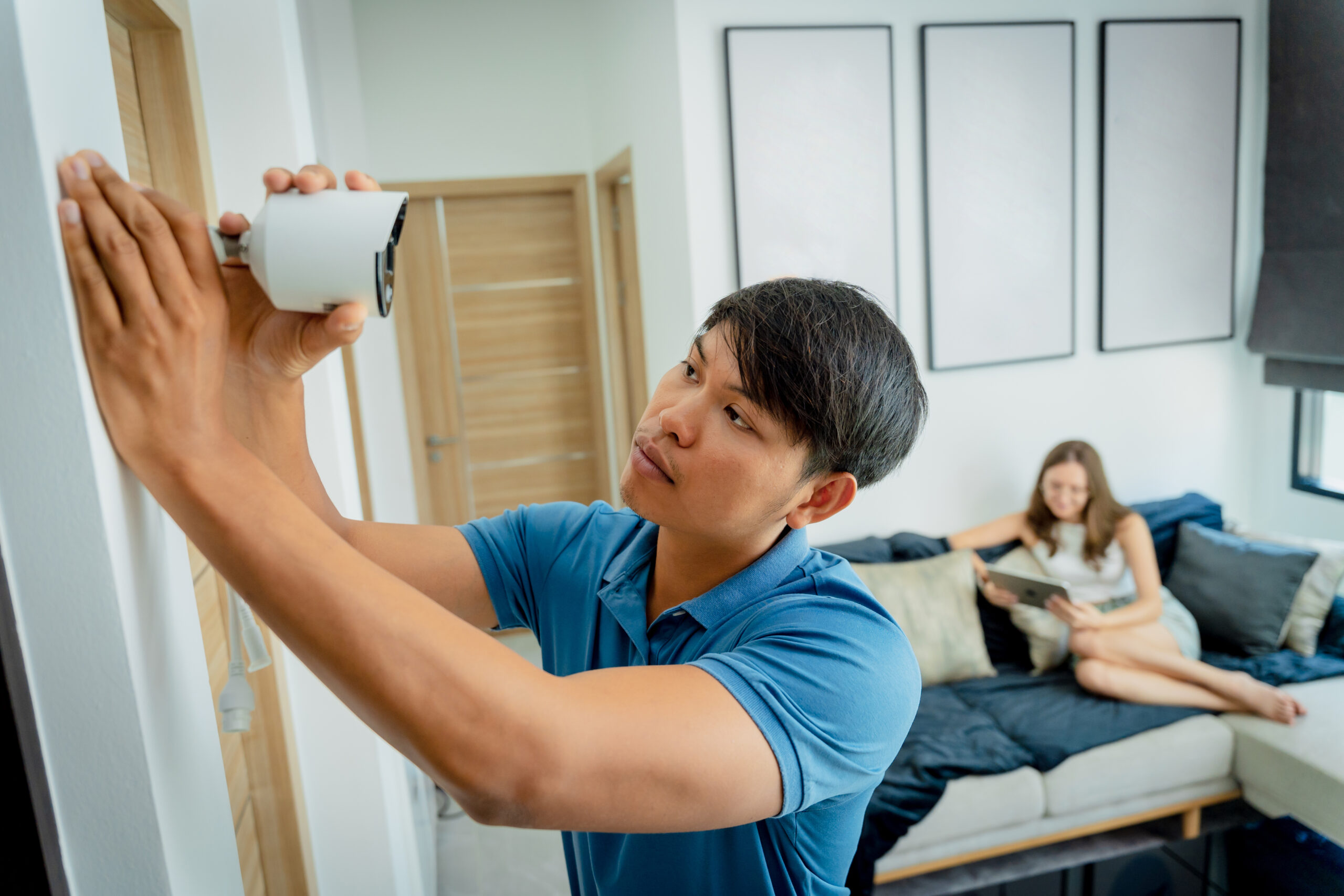Can I Install a Home Security System Myself? Find Out Here

Can I install a home security system myself? Installing a home security system has become a smart choice for many people. Professional monitoring can cost around $42 a month, while DIY options average about $24 [1]. This means homeowners can save money while keeping their space secure. Plus, today’s systems are made for easy installation, letting individuals personalize their setups.
With just a little effort, anyone can create a reliable security system at home. For tips on how to make this process smooth and what to consider before getting started, keep reading!
Key Takeaway
- DIY home security systems are budget-friendly and tailored to fit individual needs.
- Installation can usually be completed in less than an hour.
- It’s essential to review local regulations before setting up the system.
Overview of DIY Home Security Systems
Ease of Installation
Many DIY security systems come with straightforward instructions, making installation simple. People can set up their systems in as little as 30 minutes to two hours, depending on how much they want to do [2]. For example, a system can be ready in just 15 to 30 minutes. This quick setup happens because many systems come with sensors that are already connected.
Homeowners avoid tricky wiring and save money on hiring help. Most systems just need a few basic tools, like a screwdriver or a drill for mounting. Once everything is out of the box, users can follow clear step-by-step guides. There are often video tutorials online, too. This means that even those who aren’t great with technology can easily set up their security system. The simple installation process is a big reason why many choose to do it themselves.
Customization Options
One of the best things about DIY systems is that homeowners can pick exactly what they want for their homes. They can choose different sensors, cameras, and alarms to fit their needs. For instance, someone might want outdoor cameras to watch their yard, while another homeowner might need door sensors for better entry protection.
This customization lets people build a system that works for their lifestyle. Plus, as their needs change, they can adjust their security. If they add a pool or a shed, it’s easy to add more sensors or cameras. This flexibility is a big plus compared to traditional systems, which often offer fewer choices.
Affordability
Cost is another big reason why people choose DIY security systems. Basic kits usually cost between $200 and $500, which is a lot cheaper than hiring a professional. Many DIY systems also offer optional monitoring services, and these are often less expensive than traditional ones.
For instance, a professional monitoring service might charge $40 a month or more, while DIY monitoring can be as low as $10 a month. This means homeowners can keep their homes safe without spending a lot of money. Plus, most DIY systems don’t require long-term contracts, so users can cancel whenever they want without facing heavy fees.
Considerations for DIY Installation
Regulatory Compliance
Before putting in any security system, homeowners should check if they need permits. Depending on where someone lives, local laws might require permits for alarm systems. These rules can be very different from one place to another, so it’s important to ask local authorities.
Some areas have specific guidelines about how alarms should be installed or monitored. Not following these rules could lead to fines or other problems. Homeowners should also find out if their local police department has rules about false alarms. Knowing these details can help prevent issues down the road.
Limited Emergency Response

Many DIY systems depend on self-monitoring. This means that if an alarm goes off, the homeowner has to call the authorities right away. While self-monitoring can save money, it might not be as quick as having a monitored system.
In an emergency, every second counts, and delays can happen when someone is relying on themselves. Professional systems usually have monitoring centers that can alert the authorities immediately when an alarm goes off. So, homeowners who choose DIY systems should think carefully about how quickly they can respond to emergencies.
Integration Challenges
Setting up multiple devices can be tough for some DIY users. Even though many systems let people add new things, making sure everything works well together might take a little extra effort. This is especially true if homeowners want to link smart home devices, like smart lights or locks, with their security system.
Before buying anything, homeowners should check if different brands and devices will work together. Looking at online reviews or forums can help guide these choices. It’s important to remember that while DIY setups are usually easy to use, some technical skills might be needed to get the best results.
FAQ
How much does a DIY security kit cost, including monthly fees?
A basic security kit typically starts around $200, with monthly fees ranging from $10-$30 if you want professional monitoring. The system cost varies based on what components you choose. Unlike traditional systems that require long term contracts, most DIY options let you pay month-to-month, making them more budget-friendly over three year periods.
What’s included in a base station and how does it connect to my fi network?
The base station acts as your system’s brain, connecting to your home wifi and managing all your devices, entry sensors, and smart locks. It usually includes a touch screen interface and can link with voice control. Most stations work with any standard wireless network.
Can I add water leak detectors and smoke alarms to my diy system?
Yes! Most smart alarm systems let you add environmental sensors. You can connect water leak detectors and smoke alarms to your base station for real time alerts. These additional sensors work through the same mobile app as your security devices, giving you complete home protection.
How do door locks and entry points work with a diy setup?
Modern smart locks can be integrated with your diy alarm system to secure entry points. You can control door locks through your mobile app or key fob, and get live video feeds when someone enters. Many systems offer a doorbell pro option that lets you see who’s at your front door.
What camera options work best for home security?
Popular choices include cameras and video doorbells. These camera smart devices offer features like 2k video quality, live video streaming, and cam battery operation. Most best indoor cameras include night vision and two-way talk features.
How does professional monitoring work with a wired system versus a wireless diy setup?
A pro system typically requires professional installation and comes with a pro plan for monitoring. With wireless diy options, you can choose between self-monitoring through your mobile app or adding professional monitoring services. Both can offer fast protect response, but wireless systems are usually easier to install and move.
What smart home features can I add to my security kit?
Modern diy system options work well with best smart home devices. You can integrate your alarm with smart locks and camera systems. Many smart system setups also work with voice assistants like for hands-free control.
How reliable is the power source for wireless security components?
Most components run on long-lasting batteries, though some devices like the macbook pro monitoring station or live guard cameras might need a constant power source. Battery-powered devices typically notify you through the mobile app three times before batteries need changing, ensuring your system stays active.
Can I expand my offers security system over time?
Most systems let you start with a basic security kit and add components as needed. You can expand from entry sensor basics to include best video doorbells, doorbell pro cameras, and additional devices. This flexibility lets you build a comprehensive system that matches your specific needs.
What should I look for in the best diy security system?
Look for systems offering an intuitive mobile app, reliable base station, and flexible monitoring options. Good 2nd gen systems should include easy diy setup, quality touch screen controls, and the ability to integrate smart home features. Also consider whether you want self-monitoring or professional monitoring with monthly fees.
Closing Remarks
Installing a home security system yourself is a smart way to save money and personalize the setup. With many easy-to-use options available, homeowners can protect their properties without hiring professionals. However, it’s essential to check local regulations before getting started. Self-monitoring has its limits, so homeowners should think about how quickly they can respond in emergencies. Overall, DIY systems offer flexibility and cost savings for those willing to take on the project.
References
- https://www.safewise.com/resources/security-system-installation/
- https://www.security.org/home-security-systems/diy-vs-professional/